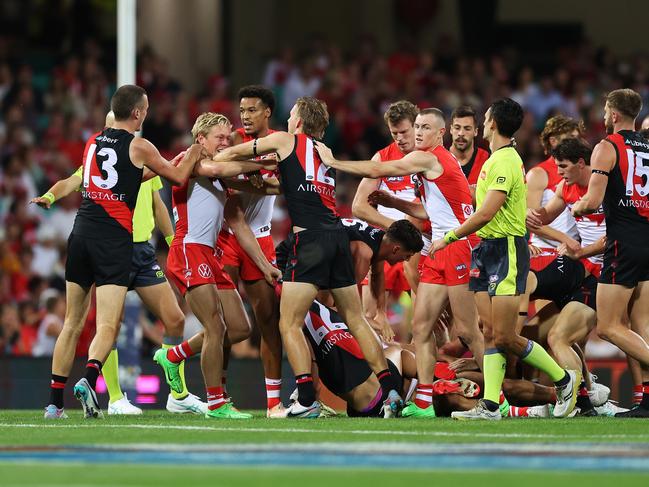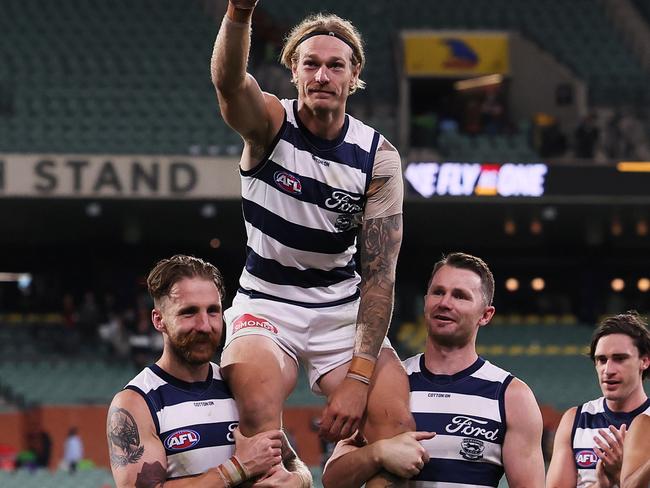The Tackle: Mark Robinson’s likes and dislikes from Round 2
They’re two of the most high-profile key defenders in the game, but MARK ROBINSON found it easy to split James Sicily and Tom Stewart on the weekend despite similar stat lines.
AFL
Don't miss out on the headlines from AFL. Followed categories will be added to My News.
It’s been a mammoth round across the AFL, with plenty of talking points.
Mark Robinson runs the ruler over his likes and dislikes from Round 2 to set the agenda for the week ahead.
DISLIKES
1. Don’t expand the season
The AFL is considering a 24-game season. It’s a concept driven by greed and money. More games means more money and the consequence will be more injuries to the players. Australian rules is already the most demanding sport in the world and if the AFL had its way, it would likely start the season in February and end it in October. It’s too much. Taylor Walker, for example, is 33 and told this masthead that he had just completed the shortest pre-season of his career. He was perplexed with the scheduling. As much as we love footy, the players aren’t robots. The early rounds always produce mass injury lists and 2024 is no different, if not worse. The AFL preaches it has players’ health and safety as a priority, yet the proposed extra games would expose football’s No. 1 commodity – the players – to greater risks. That’s more leg injuries and more head knocks which could mean more brain trauma. The AFLPA has already expressed their reluctance for an expanded season and for sure the AFL should listen.

2. The injuries mount
This round alone, Steven May (ribs) and Jake Lever (knee) couldn’t finish the game, Sydney’s Harry Cunningham was KO’d, and there was carnage for the Bulldogs on Sunday with Nick Coffield (shoulder) and Ed Richards (concussion). The season has already swallowed Keidean Coleman, Josh Gibcus, Sam Docherty, Jack Silvagni, Dan McStay, James Blanck, Josh Goater and Bailey Smith with knee injuries. Others with broken bodies include Sam Walsh (back), Connor McKenna (hamstring), Nathan Murphy (concussion), Zach Reid (hamstring), Brennan Cox (leg), Sean Darcy (knee), Cam Guthrie (quad), Gary Rohan (back), Callan Ward (shoulder), Will Day (foot), Ed Richards (concussion) and Oscar Allen (knee). Lesser-profile players swell that list even more. It’s simple: Don’t kill the golden goose by making the season even more demanding. And we certainly don’t want ‘’managed’’ to become a major part of the footy vernacular.
3. Wright is very wrong
The most meaningless defence for Essendon’s Peter Wright is: What else could he do? It’s lame. What he could’ve done was contest the footy. Sydney’s Harry Cunningham kept his eyes on the ball, knowing, as he backed into the space, that the likelihood was an opponent was coming at him. His courage was without question. Wright ran to the contest and at the final moments, he dropped his arms, tucked his body and cannoned into Cunningham. He had three choices: 1. Slow down knowing he would be late to the contest. 2. Contest the ball with a spoil, or 3. Run the risk of putting Cunningham into next week. He ran the risk. It was said Cunningham had memory loss because of the incident and that medical evidence will help deliver Wright a suspension of four to five weeks.

4. Soft Tigers
Football has opened up because of the stand rule and because coaches and players don’t want to play boring football. The cost is pressure and tackling. Richmond was credited with a meagre 21 tackles at three quarter time and finished with 33 tackles for the match, which is the lowest recorded by any team this year, according to Champion Data. Richmond’s pressure rating across the four quarters on Sunday was 149, 145, 149 and 156. In the third quarter, when Port Adelaide took hold of the game, Port’s pressure rating was 182, and they had 33 more disposals than the Tigers. Overall, Port had +41 uncontested possessions. The Tigers couldn’t defend Port, or didn’t want to defend Port. That pressure rating – 150 – was frightening and the worst by any team this year. There’s no excuse for that. Is it the way football is being played, or is it how Richmond and coach Adem Yze wants to play? The better teams have a balance between attack and defence and clearly Richmond is not among the better teams.

5. Life without Witts is tough
Co-captain Jarrod Witts missed Sunday with injury, and his tap work and bollocking at ground level left the Suns exposed. A week ago, we pondered if the Suns could have the best midfield in the game. It composed Witts, Matt Rowell, Noah Anderson, Touk Miller and Sam Flanders. Hold your beer. With rookie ruck Ned Moyle replacing Witts, and Liberatore curtailing Rowell, the Suns lost the clearance count 42-31 and the centre-square clearance 15-11. Moyle was OK in his just his third game, but he was no match for the experienced Tim English. On a windy day – when is it not in Ballarat? – the Dogs won the inside ball and then poleaxed the Suns on the outside. They lost the uncontested count by 52. Actually, poleaxed might be too kind.
6. Where is Essendon?
They remain a curiosity. Against the Swans, they conceded 12 scoring shots from the defensive 50 alone, when the league average is roughly four scores. The fact is the Bombers still get opened up despite having a pre-season centred on improving that area. On Saturday night, Sydney scored 131 points. The week before they conceded 83 points against Hawthorn, although the Hawks did kick 11.17 and subsequently was walloped by Melbourne. Early season indications suggest Essendon’s defence remains the problem profile. So, how can they be so leaky? It requires a deep dive and probably only the Bombers coaches know exactly how it’s breaking down. Do they turn over the ball too much? Can they then not defend the turnover? Is pressure the issue? Against the Swans, it was a lowly pressure rating of 167 when the league average is 180. Is it clunky at the back without Zach Reid and Jordan Ridley, and when recruit Ben McKay is not involved like he wasn’t on Saturday night? Always, it starts with pressure and the Bombers can’t deny that 167 is not close to being acceptable.

LIKES
1. Dogs respond
If the Dogs lose, Luke Beveridge can’t coach, according to some. If the Dogs win, as they did on Sunday, it’s because Bontempelli, Liberatore, English and Weightman starred and they took a club record 28 intercept marks. It’s an unfair narrative about the coach. Beveridge had his team ginned up for the Suns contest and got great return from Buku Khamis, Oskar Baker and Lachie Bramble, three players Beveridge maintained the faith with. “Bevo’s messaging was really positive … take to them and see if they can handle the heat,” six-goal hero Weightman told Fox Footy in the post-match. The Dogs defended with purpose in the air and kicked 18.7 in attack, and for that, the players deserve the plaudits. But so, too, does Beveridge. He put in place a plan and the players responded. Liberatore vs. Rowell was a highlight, Sam Darcy played defence and forward and, gee, he’s going to be some sort of player. And Ryley Sanders’ six clearances was third most behind ‘Bont’ and ‘Libba’. This was the Dogs at their all-round best, and with Jack Macrae amassing 47 disposals and 17 clearances in the VFL, the team can only get better. Now, will the Beveridge critics pull their heads in?

2. Willem Drew
He’s the fourth wheel in Port Adelaide’s midfield and his value keeps growing. He was a ‘jobber’, as Dermott Brereton calls certain role players, and Drew has developed his craft to be far more than that. He will get the shutdown job when it’s needed, but he’s added ball winning to his game. He had 27 against Richmond on Sunday, and also had a directive to look after Tim Taranto and Shai Bolton when they were in the midfield. He shared those contests. In Travis Boak’s 350th game, Port had Butters, Rozee, Wines and Drew as their main midfield mix. Port’s forwards certainly weren’t starved. Todd Marshall kicked four goals, Jeremy Finlayson three and Charlie Dixon two, and those three took a combined 11 marks inside 50. Richmond took seven overall, which is the same amount Marshall took himself. It was far from a demolition, and you get the feeling Port has more in them. They’d want to. They’ve beaten West Coast and Richmond and it’s difficult to judge how good this team is. We’ll find out soon enough.

3. The hybrid Saints
St Kilda has assembled a bunch of ‘hybrid’ players, which are players standing between 185cm and 192cm and who can play multiple positions. They are Mitch Owens (191cm), Mattaes Phillipou (190cm), Nasiah Wanganeen-Milera (187cm), Marcus Windhager (185cm), Darcy Wilson (185cm), Riley Bonner (190cm), Jack Steele (187cm), Seb Ross (187cm), Josh Battle (192cm), Cooper Sharman (192cm), Mason Wood (192cm), Tim Membrey (188cm), Callum Wilkie (191cm), and Brad Crouch (186cm). It gives coach Ross Lyon so much flexibility, as Channel 7 commentator Joel Selwood has highlighted several times. Some of them can play key forward-ruck, as Owens did against Collingwood on Thursday night, and others can play half-back, wing and on-ball, cue Windhager getting the stopping job on Jordan de Goey in the same game. Unquestionably, speed is king at St Kilda, and flexibility is not too far behind.

4. Slick Swans
Football is about possessions. If one team has the ball, the other team doesn’t. And then it’s about what the team does with the ball which separates wins from losses. The Swans get value for their possessions, which is why this talent-laden mob is not only one of the most exciting teams, but also one of the flag contenders. Simply, their midfielders turn possessions into scores. Look at Saturday night’s game and compare Sydney’s major ball-winners against Essendon’s major ball winners. The Swans had Isaac Heeney (32 touches and 13 involvements), Chad Warner (28 and 14), Tom Papley (24 and 13), Errol Gulden (24 and 11), Justin McInerney (22 and 11) and Jake Lloyd (22 and eight). Essendon’s list was Zach Merrett (32 disposals and 10 score involvements), Nic Martin (31 and four), Will Setterfield (29 and seven), Andy McGrath (25 and two), Jade Gresham (23 and 11) and Archie Perkins (21 and four). Sydney’s top dogs had a combined 70 score involvements compared to Essendon’s 38 score involvements. Clearly, the Swans’ midfield group influenced the scoreboard and outside of the hard-working Merrett, the Essendon midfield laboured.

5. Stewart v Sicily
It’s a tale of two key defenders and which one of them had the greater impact on their game. The answer is Stewart easily. The Cats great took 10 intercept marks, an equal record, and was widely acknowledged as being BOG on Friday night. Even Crows coach Matthew Nicks took a kicking for allowing Stewart to be so dominant, and not ensuring he had a player to contend with. Compare that to Sicily. The Hawks skipper took nine marks in the first quarter alone, when the Hawks played keepings off in the back half. Colleague Scott Gullan, who was at the game, said Hawthorn’s ball movement was embarrassing and compounded by the fact the Hawks kicked just one behind to Melbourne’s five goals. Sicily finished with 13 marks (two intercepts) and had four goals kicked on him. Stewart took 11 marks, had seven score involvements and had zero goals kicked by his opponents. Incredibly, Stewart was credited with 134 ranking points and Sicily had 123 points, when Stewart’s game was far more superior.

6. Action Jackson
Luke Jackson is a young Brodie Grundy, a ruck-roving ruckman which means he is more a midfielder than he is ruckman. Grundy was just that when he and Max Gawn were considered the best two centre-square big men in the game. All the talk about Jackson being a more influential player in the middle than he is as a forward makes tremendous sense. The question remains: Where will Jackson play when Sean Darcy returns? With the Docker establishing a potent forward six, headed by Amiss, Treacy and Taberner on Saturday, is it possible Jackson can join Darcy, Caleb Serong and Andrew Brayshaw in the centre square? Or does that make the Dockers too cumbersome through the middle? Two players vying for the same spot is not new in football. Older footy fans would remember when Richmond had Michael ‘Disco’ Roach and a young tearaway called Brian Taylor vying for the full-forward position. Roach was the number one pick, which meant BT played reserves. When they did play together, it didn’t work that well because back then there was one focal point and not the spread of options like there is today. BT played 43 games for Richmond before requesting a trade to Collingwood. “It was about opportunity,” Taylor said on Sunday.
More Coverage
Originally published as The Tackle: Mark Robinson’s likes and dislikes from Round 2





